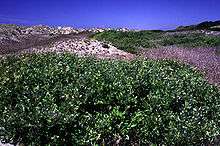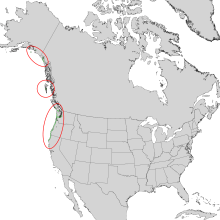Salix hookeriana
| Salix hookeriana | |
|---|---|
 | |
| Scientific classification | |
| Kingdom: | Plantae |
| (unranked): | Angiosperms |
| (unranked): | Eudicots |
| (unranked): | Rosids |
| Order: | Malpighiales |
| Family: | Salicaceae |
| Genus: | Salix |
| Species: | S. hookeriana |
| Binomial name | |
| Salix hookeriana Barratt ex Hook. | |
 | |
| Natural range of Salix hookeriana | |
 | |
| Close-up of natural range | |
| Synonyms | |
| |
Salix hookeriana is a species of willow known by the common names dune willow, coastal willow, and Hooker's willow.
Description
Salix hookeriana is a shrub or tree growing up to 8 m (26 ft) tall, sometimes forming bushy colonial thickets. The leaves are up to 11 cm long, generally oval in shape, wavy along the edges, and hairy to woolly in texture with shiny upper surfaces.
The inflorescence is a catkin of flowers up to 9 cm long, with the female catkins growing longer as the fruits develop.
This willow may hybridize with similar species.
Taxonomy
The Latin specific epithet hookeriana refers to Sir Joseph D. Hooker.[1]
Distribution
The plant is native to the west coast of North America from Alaska to northern California, where it grows in coastal habitat such as beaches, marshes, floodplains, and canyons.
 At the Humboldt Bay National Wildlife Refuge, California
At the Humboldt Bay National Wildlife Refuge, California
References
- ↑ Sue Gordon (Editor) Horticulture - Plant Names Explained: Botanical Terms and Their Meaning, p. 84, at Google Books
External links
![]() Media related to Salix hookeriana at Wikimedia Commons
Media related to Salix hookeriana at Wikimedia Commons
- Jepson Manual Treatment: Salix hookeriana
- Washington Burke Museum
- Salix hookeriana — U.C. Photo gallery